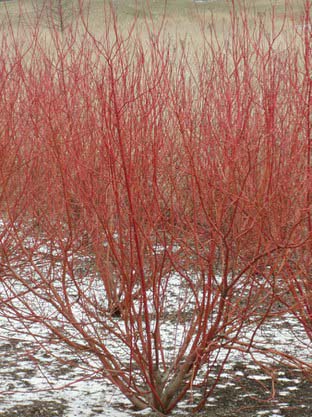For Winter Interest Try Red Twig Dogwood
By Gil Medeiros, Fairfax Master Gardener
When the deciduous trees drop their leaves, and the herbaceous plants hibernate for the winter, we rely mainly upon evergreens to decorate the landscape. The landscape desperately needs the green color to add some life during the gray winter months, but more color would be even better.

Red twig dogwood ‘Cardinal’
September and October are good months to plant these native deciduous shrubs.
The attraction of these plants is that the stems take on an intense red or yellow color in winter. These colors stand in stark contrast to the leaden gray of the winter sky, the dull gray or brown of tree trunks, the green of evergreens, and, of course, the white of snow. The most intense colors on Cornus sericea are displayed by new growth so it important to prune out the biggest and oldest stems to the base of the plant each year in late winter. This is renewal pruning in which about a third of the stems are removed each year. These shrubs should never be sheared as a hedge.
Red twig dogwoods grow to about 7 to 10 feet in height, and 5 to 7 feet in spread. They are remarkably tolerant plants: soil conditions from wet to dry, pH from acid to alkaline, and sun from full to part shade. In 2011 we planted two red twigs (‘Baileyi’) and one yellow twig (‘Flaviramea’) in a shade garden where they get about 2-3 hours of direct sun in the middle of the day. They are growing in the same area as many ferns and hostas; the soil there is moist in spring and tends to dry out in summer. Indeed, Cornus sericea is a good choice for the edge of rain gardens.
Our red twigs grow from a multi-stemmed trunk. The yellow twig is more of a colonizer, growing from stolons that independently root along the ground. The spread is easily controlled by pruning.
These plants are generally hardy from zones 2-8 although there may be some variation in hardiness among different cultivars. (Fairfax County is in USDA zone 7.) Cornus sericea can be subject to leaf spot and stem canker here in zone 7, but the problems are more severe in warmer zone 8. In the five plus years we have grown them the red twigs were afflicted with leaf spot one fall. We made sure to clean up carefully the fallen leaves and have not seen the problem since. The yellow twig has had no problems at all.
The three-inch leaves of some red twigs turn orange to yellow and eventually purple in fall. No, Cornus sericea won’t produce pretty flowers like the dogwood (Cornus florida) that graces so many landscapes in Northern Virginia. However, the small white flowers develop into fruit that the small birds in my yard avidly consume through the late spring and early summer.
Red twigs can be propagated by cuttings taken on new growth in late winter. Cuttings should be about 8 inches in length and taken from the tips of fat, actively growing stems. They can be planted in well-watered soil in a pot filled to 5 inches and placed in a protected place. They can be planted in the ground the following fall.
So if Santa decorations are the only bright red you see out your windows in the winter, or yellow in the landscape will brighten your dark winter days, try Cornus sericea.
Resources
Red Twig Dogwoods, Tatarian Dogwood (Cornus alba) and Redosier Dogwood (Cornus sericea), Virginia Cooperative Extension, 3010-1497
Shrub of the Month: ‘Cardinal’ Red Twig Dogwood (Cornus sericea), Penn State University Extension
Cornus sericea ‘Cardinal,’ Missouri Botanical Garden
Fiery Red Twig Dogwood Multiplies Easily, University of Illinois Extension